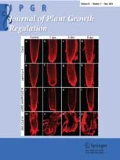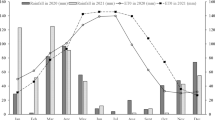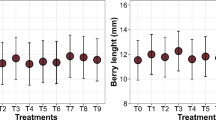Abstract
Abiotic stresses affect plant development in different ways depending on the phase of ontogeny. Exposure to moderate stress may induce cross-tolerance resulting in complex acclimation. The improvement of vegetable transplants able to withstand outdoor conditions is achieved by controlled stress applications. The aim of the experiment was to investigate the effects of diverse chilling treatments applied to transplants on subsequent broccoli development and yield. The evidence for a long-lasting “stress imprint” effect during plant ontogeny was investigated. Transplants were subjected to temperatures of 6, 10, and 14 °C maintained for 7 and 14 days before planting out, and to 18 °C (control). The fresh weight (FW), dry weight (DW), and chosen leaf parameters were measured five times in 10-day intervals, starting 21 days after transplanting (DAT). At first sampling, the FW and DW of control plants were slightly higher in comparison to previously chilled plants, but finally (at 61 DAT) chilling increased both the FW and DW of broccoli, particularly in the 6 °C for 7 days (FW) and 14 °C for 7 days (FW and DW) treatments. Polynomial regression models for alterations in DW content over time were developed and validated. All models showed a high accuracy of prediction, indicating that they could be useful tools for describing broccoli development. The growth rate and relative growth rate showed alterations during field cultivation, due to the chilling treatments of the transplants, up to 41 DAT. The effect of chilling on leaf number per plant was observed only after 2 months of vegetative growth, when broccoli treated with 10 °C for 7 days had the highest number of leaves. Leaf surface area and leaf perimeter were significantly influenced by chilling only at 31 DAT. Broccoli subjected to 6 °C for 14 days formed leaves with the highest surface area and largest perimeter as compared with the control. At 61 DAT, all leaf parameters of chilled plants were slightly higher than the control; however, differences for leaf surface area and perimeter were not confirmed statistically. Treatment with 10 °C for 7 days, resulted in an increase in yield, by 2.38 t ha−1, in relation to the control. A regression model including microclimatic parameters for the prediction of broccoli yield was proposed in this paper. The collected data showed the long-term effects of transplant chilling on subsequent broccoli development and yield, and the existence of “stress memory.”


Similar content being viewed by others
References
Artuso A, Guidi L, Soldatini GF, Pardossi A, Tognoni F (2000) The influence of chilling on photosynthesis and activities of some enzymes of sucrose metabolism in Lycopersicon esculentum mill. Acta Physiol Plant 22(2):95–101
Bartwal A, Mali R, Lohani P, Guru SK, Arora S (2013) Role of secondary metabolites and brassinosteroids in plant defense against environmental stresses. J Plant Growth Regul 32:216–232
Bruce TJA, Matthes MC, Napier JA, Pickett JA (2007) Stressful “memories” of plants: evidence and possible mechanisms. Plant Sci 173(6):603–608
Carranza C, Lanchero O, Miranda D, Salazar MR, Chaves B (2008) A simple simulation model of dry matter distribution in broccoli (Brassica sp.) variety coronado and cabbage (Brassica oleracea) hybrid delus cultivated in Bogotá plateau. Agron Colomb 26(1):23–31
Chinnusamy V, Zhu J, Zhu JK (2007) Cold stress regulation of gene expression in plants. Trends Plant Sci 12:444–451
Długosz-Grochowska O, Leja M, Grabowska A, Kunicki E (2012) The effect of preliminary chilling of broccoli transplants on some antioxidative parameters. Folia Hortic 24(2):131–139
Ercoli L, Mariotti M, Masoni A, Arduini I (2004) Growth responses of sorghum plants to chilling temperature and duration of exposure. Eur J Agron 21(1):93–103
Grabowska A, Kunicki E, Libik A (2007) Effects of age and cold storage of transplants on the growth and quality of broccoli heads. Veg Crops Res Bull 66(1):31–38
Iba K (2002) Acclimative response to temperature stress in higher plants: approaches of gene engineering for temperature tolerance. Annu Rev Plant Biol 53:225–245
Javanmardi J, Rahemi M, Nasirzadeh M (2013) Physiological and reproductive responses of tomato and pepper transplants to low-temperature conditioning. Int J Veg Sci 19(3):294–310
Jian L-C, Lu C-F, Li J-H, Li PH (2005) Increment of chilling tolerance and its physiological basis in chilling-sensitive corn sprouts and tomato seedlings after cold-hardening at optimum temperatures. Acta Agron Sin 31(8):971–976
Kage H, Stützel H, Alt C (2001) Predicting dry matter production of cauliflower (Brassica oleracea L. botrytis) under unstressed conditions. Part II. Comparison of light use efficiency and photosynthesis respiration based modules. Sci Hortic 87:171–190
Kalisz A (2010) Optimising transplant quality and the yielding of Chinese cabbage (Brassica pekinensis Rupr.). A study with some elements of plant development modeling. Zesz Nauk UR w Krakowie, ser. Rozprawy 465(342):1–121
Kalisz A, Cebula S, Kunicki E, Gil J, Sękara A, Grabowska A (2014a) Effect of chilling stress before transplanting on morphological parameters of broccoli heads. Acta Sci Pol Hortorum Cultus 13(1):129–139
Kalisz A, Sękara A, Cebula S, Grabowska A, Kunicki E (2014b) Impact of low-temperature transplant treatment on yield and quality of cauliflowers curds in late spring production. Sci Hortic 176:134–142
Kato-Noguchi H (2007) Low temperature acclimation to chilling tolerance in rice roots. Plant Growth Regul 51:171–175
Korkmaz A, Dufault RJ (2001) Developmental consequences of cold temperature stress at transplanting on seedling and field growth and yield I. Watermelon. J Am Soc Hortic Sci 126(4):404–409
Li H-Y, Li C-G, Gong M (2011) Short-term cold-shock at 1 °C induced chilling tolerance in maize seedlings. Energy Procedia 11:2148–2154
Lukatkin AS, Brazaityté A, Bobinas Č, Duchovskis P (2012) Chilling injury in chilling-sensitive plants: a review. Žemdirbysté (Agriculture) 99(2):111–124
Ruelland E, Vaultier M-N, Zachowski A, Hurry V (2009) Cold signalling and cold acclimation in plants. Adv Bot Res 49:35–150
Sasaki H, Ichimura K, Oda M (1996) Changes in sugar content during cold acclimation and deacclimation of cabbage seedlings. Ann Bot 78:365–369
Sato F, Yoshioka H, Fujiwara T (1999) Effect of storage temperature on carbohydrate content and seedling quality of cabbage plug seedlings. Environ Control Biol 37(4):249–255
Sękara A, Bączek-Kwinta R, Kalisz A, Cebula S (2012) Tolerance of eggplant (Solanum melongena L.) seedlings to stress factors. Acta Agrobot 65(2):83–92
Sharma P, Jha AB, Dubey RS, Pessarakli M (2012) Reactive oxygen species, oxidative damage, and antioxidative defense mechanism in plants under stressful conditions. J Bot 2012:1–26
Slováková L, Matušíková I, Salaj J, Hudák J (2010) Effect of low temperatures on the structure of plant cells: structural, biochemical, and molecular aspects. In: Pessarakli M (ed) Handbook of plant and crop stress. CRC Press, London, pp 536–554
Tei F, Aikman DP, Scaife A (1996) Growth of lettuce, onion and red beet. 2. Growth modeling. Ann Bot 78:645–652
UNECE standard FFV-48 (2010) Concerning the marketing and commercial quality control of broccoli, New York
Uzun S, Kar H (2004) Quantitative effects of planting time on vegetative growth of broccoli (Brassica oleracea var. italica). Pak J Bot 36(4):769–777
Venema JH, Villerous L, van Hasselt PR (2000) Effects of acclimation to suboptimal temperature on chilling-induced photodamage: comparison between a domestic and a high-altitude wild Lycopersicon species. Plant Sci 152:153–163
Wojciechowska R, Hanus-Fajerska EJ, Kołton A, Kamińska I, Grabowska A, Kunicki E (2013) The effect of seedling chilling on glutathione content, catalase and peroxidase activity in Brassica oleracea L. var. italica. Acta Soc Bot Pol 82(3):243–248
Xu P-L, Guo Y-K, Bai J-G, Shang L, Wang X-J (2008) Effects of long-term chilling on ultrastructure and antioxidant activity in leaves of two cucumber cultivars under low light. Physiol Plant 132:467–478
Zhang L, Kong X, Hu I, Zhang M (2008) The low temperature, light and seedling age requirement for seedling vernalization in Chinese cabbage. Acta Hort Sin 35(11):1676–1680
Acknowledgments
This work was supported by the National Science Centre, Poland–Grant No. N N310 305239.
Author information
Authors and Affiliations
Corresponding author
Rights and permissions
About this article
Cite this article
Kalisz, A., Sękara, A., Grabowska, A. et al. The Effect of Chilling Stress at Transplant Stage on Broccoli Development and Yield with Elements of Modeling. J Plant Growth Regul 34, 532–544 (2015). https://doi.org/10.1007/s00344-015-9488-7
Received:
Accepted:
Published:
Issue Date:
DOI: https://doi.org/10.1007/s00344-015-9488-7




